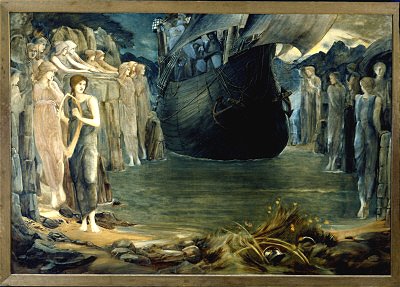His early success was in stained glass and he taught the subject from 1859 to 1861. He studied the nude and the Antique during the late 1860's and improved his draughtsmanship, and use of watercolor and oils. He developed into a fine colorist, and his sense of line was powerful. The serpentine rythms he eveloped while under the influence of Botticelli are characteristic of Burne-Jones paintings. Burne-Jones was a leading figure in the second Pre-Raphaelite movement which was a mixture of romantic medievalism and the desire to return to a realistic depiction of nature. His taste was rather classical and his elongated shapes, influenced by Botticelli, and his paintings of ethereally beautiful women were quite popular at the end of the century. Subject: In Homer's poem "The Odyssey", Odysseus was warned about the Sirens by Circe, the magician. She directed Odysseus to fill the ears of his seamen with wax so that they should not hear the Siren's song. He himself was to be bound to the mast and orders given to his crew not to release him until they should have passed the Siren's island. Painting: This is a study in chiaroscuro. It is ghostly in its presentation.The sky is dangerous - the play of shadows - light and dark grays - make the scene seem unearthly and cold. The moment chosen for depiction is just before the wreck of the ship and the destruction of all aboard. The painting can be seen as containing symbolic elements or merely as a mythological / historical pictorial representation. Historical Context: Bourne-Jones' paintings of subjects from medieval legend and Classical mythology played an important part in the Aesthetic Movement and the history of international Symbolism which rejected objectivity in favor of the subjective and turned away from the direct representation of reality in favor of ambiguous yet powerful symbols. This painter was different - he suffered from depression and became isolated artistically. |
